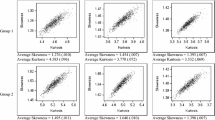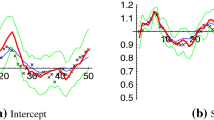Abstract
We apply the Kalman Filter to the analysis of multi-unit variance components models where each unit's response profile follows a state space model. We use mixed model results to obtain estimates of unit-specific random effects, state disturbance terms and residual noise terms. We use the signal extraction approach to smooth individual profiles. We show how to utilize the Kalman Filter to efficiently compute the restricted loglikelihood of the model. For the important special case where each unit's response profile follows a continuous structural time series model with known transition matrix we derive an EM algorithm for the restricted maximum likelihood (REML) estimation of the variance components. We present details for the case where individual profiles are modeled as local polynomial trends or polynomial smoothing splines.
Similar content being viewed by others
References
Anderson, S. J. and Jones, R. H. (1995). Smoothing splines for longitudinal data, Statistics in Medicine, 14, 1235–1248.
Ansley, C. F. and Kohn, R. (1985). Estimation, filtering and smoothing in state space models with incompletely specified initial conditions, Ann. Statist., 13, 1286–1316.
Ansley, C. F. and Kohn, R. (1990). Filtering and smoothing in state space models with partially diffuse initial conditions, J. Time Ser. Anal., 11, 275–293.
De Jong, P. (1988). A cross-validation filter for time series models, Biometrika, 75, 594–600.
De Jong, P. (1989). Smoothing and interpolation with the state space model, J. Amer. Statist. Assoc., 84, 1085–1088.
De Jong, P. (1991). The diffuse Kalman filter, Ann. Statist., 19, 1073–1083.
De Jong, P. and McKinnon, M. (1988). Covariances for smoothed estimates in state space models, Biometrika, 75, 601–602.
Hartiey, H. O. and Rao, J. N. K. (1967). Maximum likelihood estimation for the mixed analysis of variance model, Biometrika, 54, 93–108.
Harvey, A. C. (1989). Forecasting, Structural Time Series Models and the Kalman Filter, Cambridge University Press, Cambridge.
Harville, D. A. (1977). Maximum likelihood approaches to variance component estimation and to related problems, J. Amer. Statist. Assoc., 72, 320–340.
Jones, R. H. (1993). Longitudinal Data with Serial Correlation: A Stute Space Approach, Chapman Hall, London.
Kohn, R. and Ansley, C. F. (1986). Estimation, prediction and interpolation for ARIMA models with missing data. J. Amer. Statist. Assoc., 81, 751–761.
Koopman, S. J. (1993). Disturbance smoother for state space models, Biometrika, 80, 117–126.
Koopman, S. J. and Shephard, N. (1992). Exact score for time series models in state space form, Biometrika, 79, 823–826.
Laird, N. M. and Ware, J. H. (1982). Random effects models for longitudinal data, Biometrics, 38, 963–974.
Laird, N. M., Lang, N. and Stram, D. (1987). Maximum likelihood computations with repeated measures: application of the EM algorithm, J. Amer. Statist. Assoc., 76, 860–869.
Sallas, W. M. and Harville, D. A. (1981). Best linear recursive estimation for mixed linear models, J. Amer. Statist. Assoc., 82, 97–105.
Searle, S. R., Casella, G. and McCulloch, C. E. (1992). Variance Components, Wiley, New York.
Tsimikas, J. and Ledolter, J. (1994). REML and best linear unbiased prediction in state space models, Comm. Statist. Theory Methods, 23(8), 2253–2268.
Tsimikas, J. and Ledolter, J. (1997). Mixed model representation of state space models: mew smoothing results and their application to REML estimation, Statistica Sinica (forthcoming).
Wecker, W. E. and Ansley, C. F. (1983). The signal extraction approach to nonlinear regression and spline smoothing, J. Amer. Statist. Assoc., 78, 81–89.
Wilson, D. P. (1995). Longitudinal data analysis for linear Gaussian models with random disturbed-highest-derivative-polynomial subject effects, Statistics in Medicine, 14, 1219–1233.
Author information
Authors and Affiliations
About this article
Cite this article
Tsimikas, J.V., Ledolter, J. Analysis of Multi-Unit Variance Components Models with State Space Profiles. Annals of the Institute of Statistical Mathematics 50, 147–164 (1998). https://doi.org/10.1023/A:1003405615641
Issue Date:
DOI: https://doi.org/10.1023/A:1003405615641




